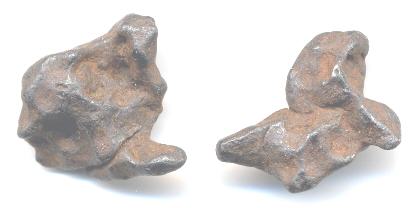Iron, IAB complex, main group

Found before 1922
31° 43′ N., 102° 24′ W. Over 1,000 kg of meteoritic material have been recovered in and around a small rimmed craterBowl-like depression ("crater" means "cup" in Latin) on the surface of a planet, moon, or asteroid. Craters range in size from a few centimeters to over 1,000 km across, and are mostly caused by impact or by volcanic activity, though some are due to cryovolcanism. Click on Term to Read More measuring 165 m in diameter and its associated impact holes. While the original crater, which was formed ~50,000 years ago, is thought to have measured ~180 m wide and ~30 m deep, the crater that remains today is only ~2 m deep with a rim ~2 m high.
Odessa is a coarse
octahedriteMost Common type of iron meteorite, composed mainly of taenite and kamacite and named for the octahedral (eight-sided) shape of the kamacite crystals. When sliced, polished and etched with an acid such as nitric acid, they display a characteristic Widmanstätten pattern. Spaces between larger kamacite and taenite plates are often Click on Term to Read More assigned to the main group of the IAB complex (Wasson and Kallemeyn, 2002). Troilite–graphite–
silicateThe most abundant group of minerals in Earth's crust, the structure of silicates are dominated by the silica tetrahedron, SiO44-, with metal ions occurring between tetrahedra). The mesodesmic bonds of the silicon tetrahedron allow extensive polymerization and silicates are classified according to the amount of linking that occurs between the aggregates are widespread in Odessa specimens, and
coheniteFe-Ni-Co carbide, (Fe,Ni,Co)3C, that occurs as an accessory constituent in several iron meteorites, and coarse octahedrites with < 7 wt. % Ni. Click on Term to Read More is common. These inclusions are chondritic in nature, contain planetary rare gas elements, and were likely formed within partial melts generated through impact events that occurred very early in
Solar SystemThe Sun and set of objects orbiting around it including planets and their moons and rings, asteroids, comets, and meteoroids. history at a location near 1
AUThe astronomical unit for length is described as the "mean" distance (average of aphelion and perihelion distances) between the Earth and the Sun. Though most references state the value for 1 AU to be approximately 150 million kilometers, the currently accepted precise value for the AU is 149,597,870.66 km. The Click on Term to Read More. Odessa has a very high CRE age of 875 (±70) m.y. (Voshage and Feldmann, 1979).
Information on the formation of the IAB complex silicated irons can be found on the
Landes page. Pictured above are two ‘Baby Odessa’ individual fragments having a combined weight of 6.5 grams.







